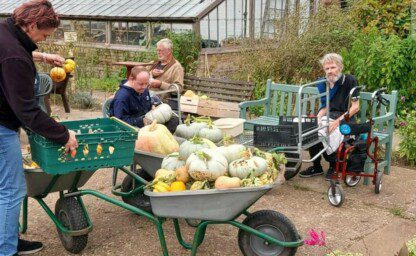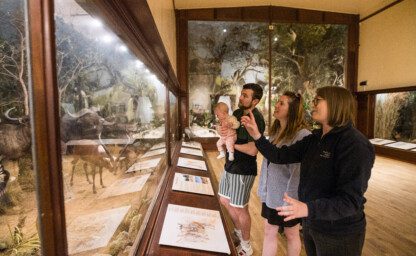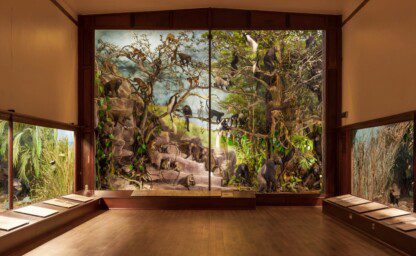The Sunshine Project
Our community outreach project providing vulnerable adults with meaningful volunteering opportunities.
There has been a manor house at Quex since 1449 and at that time, owned by John Quekes. The house we see today is located in a different area of the property and is a fairly modern renovation of the 1816 design by Thomas Hardwick (commissioned by John Powell). The Powell-Cotton’s continued renovations to make Quex House a comfortable family home. Today, half of the house is under the ownership of the Powell-Cotton Trust, est.1926 and half remains in private ownership.
The Entrance Hall
The present Hall was enlarged and remodelled around 1900 in a fashionable ‘Baronial’ style. With the original staircase rebuilt in English oak against the east wall, the room provided a space to welcome visitors. Oak furniture from the 17th century, oil paintings reflecting the family’s maritime history and a fine longcase clock by Thomazon Fitter of Clerkenwell ensure an impression of heritage.
The Oriental Room
This beautiful room was a late 19th-century extension of the house. It was built as a room for entertainment but also intriguingly served as a VAD ward during the Second World War. Today, the furniture is arranged based on photos from the 1910s, when it served as a formal sitting room.
The room features carved Kashmir walnut, used as a framework for sumptuous embroidery taken from Chinese Imperial robes, numerous elegant light fittings and a ‘temple’ of a fireplace. The furniture, originally made mainly for the European market, is from India, China and Japan. Red lacquer dragon chairs stand proudly alongside an elegant Japanese moon-shaped domestic shrine. Intricate bronzes and fine ceramics complete the room. Arguably, the most breathtaking feature is the patterned papier mache ceiling.
The Armoury
No longer used to house weapons, portraits of six generations look down on treasured family objects – a “Benjamin Franklin’ clock, possibly made for John Powell Powell, enticing Napoleonic memorabilia, pewter and glass hint at some intriguing family connections and collecting passions.
The Powell Room
Arranged to represent its service as a guest bedroom, this space is dominated by an elegant mahogany four-poster bed. Along the walls, there are cabinets and sideboards showcasing ceramic collections and smaller family heirlooms. On the wall, there is a portrait of Diana Powell-Cotton as a child. The curtains reveal a beautiful view across the front lawn and meadow.
The Library
A staff and visitor favourite, this room is home to over 3000 books collected by six generations of the Powell-Cotton family. The room was also used as a sitting room with comfortable furniture. On the island reading desk is the Congreve or rolling-ball clock. Designed by William Congreve, inventor, engineer and creator of the rocket batteries of the Napoleonic wars, it was made for John Powell-Powell in 1820.
The portrait over the fireplace is of Hannah Powell-Cotton, who married Percy Powell-Cotton in 1905. Although we don’t have many of her records, we know she highly involved in the creation and running of the museum. The painter who created the portrait also created some of the backgrounds in the dioramas.
The Boudoir
This room and the library used to be one large withdrawing room, and you can still see the outline of the large door that would have connected them. They were split to create a private space for Hannah Powell-Cotton and since this room was created for her, it is decorated very differently from the rest of the house. The colour scheme is much lighter, there are comfortable seats and small drinks and games tables. In the corner sits a fortepiano, which opposed to a full grand piano only has 5 ½ octaves. Furniture echoes the Hepplewhite period, using satinwood and mahogany inlaid with a variety of coloured woods. On sunny days, this room catches the light beautifully.
Visitors can view Quex House via a guided tour on any of our open days or groups can book a private weekday visit. The tour of the house comprises 6 rooms of varying sizes, 3 downstairs, and 3 upstairs. Most of the ground floor is wheelchair accessible. The rooms are mostly dressed to reflect historic photographs, showing how they would have been used between 1900 and 1940.
Quex Gardens
The gardens at Quex were originally laid out in the fifteenth century when the first manor house was built but was extensively remodelled throughout the nineteenth century so that the present design contains strong Regency, Victorian and Edwardian influences.
The gardens were designed to be viewed from the main withdrawing room on the first floor of the house, from where lawns radiate around a central vista ending in the far distance with the Gun Tower, one of three follies in the grounds. The established parkland contains numerous ornamental specimen trees and a sunken fountain garden. This feature was once a formal Italianate garden but now the formal borders and paths, ponds and statues have been reestablished.
On the upper terraces of the lawn, there are some fine specimen trees, including two venerable King James Mulberries and an ancient Sophora Japonica. A vibrant Edwardian herbaceous border can be found against the south wall of the kitchen garden. A more recent introduction is a rose border, established with the help of David Austin Roses, which contains a collection of old roses and some new introductions.
Hidden behind the high, old brick walls of the herbaceous border is an exceptional example of a Victorian walled garden, which had later commercial use as a market garden. Over time the glasshouses have undergone careful restoration. The main glasshouses are the next areas to undergo extensive repair once funding has been secured. Collections of tender exotics,
fruit trees, cacti, succulents & pelargoniums are found within. Work is ongoing to preserve the glasshouse structures and to raise heritage fruit and vegetable varieties.
Surrounding the gardens is a woodland walk, with a good show of spring bulbs and planted beds, contrasting with the more formal pleasure grounds of the mansion.
From 1883 James Cornford was Head Gardener at Quex and by 1902 about twenty gardeners were employed. Today we have a small team of employed gardeners who work with many volunteer groups. Recently we received a generous grant from the AIM (Association of Independent Museums) Connected Communities fund which will enable us to take significant strides in fostering high-quality volunteering opportunities, community engagement, and social connectivity, with a specific focus on individuals with learning disabilities and/or mental health challenges. If you know someone who might benefit from this opportunity, please find out more here: Sunshine Project

Our community outreach project providing vulnerable adults with meaningful volunteering opportunities.

All the information you need to help you plan your day out with us.

Discover the permanent exhibitions in the museum.